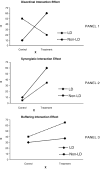Evaluating mediation and moderation effects in school psychology: a presentation of methods and review of current practice
- PMID: 20006988
- PMCID: PMC5488867
- DOI: 10.1016/j.jsp.2009.09.001
Evaluating mediation and moderation effects in school psychology: a presentation of methods and review of current practice
Abstract
Third variable effects elucidate the relation between two other variables, and can describe why they are related or under what conditions they are related. This article demonstrates methods to analyze two third-variable effects: moderation and mediation. The utility of examining moderation and mediation effects in school psychology is described and current use of the analyses in applied school psychology research is reviewed and evaluated. Proper statistical methods to test the effects are presented, and different effect size measures for the models are provided. Extensions of the basic moderator and mediator models are also described.
Figures







Similar articles
-
Third variables in longitudinal research: Application of longitudinal mediation and moderation in school psychology.J Sch Psychol. 2024 Apr;103:101283. doi: 10.1016/j.jsp.2024.101283. Epub 2024 Jan 20. J Sch Psychol. 2024. PMID: 38432732
-
Expanding school psychology's horizons for understanding and conducting research: commentary on the special series on statistical analysis.J Sch Psychol. 2010 Feb;48(1):1-4. doi: 10.1016/j.jsp.2009.11.001. J Sch Psychol. 2010. PMID: 20006985 No abstract available.
-
Contemporary applications of moderation analysis in counseling psychology.J Couns Psychol. 2018 Oct;65(5):629-640. doi: 10.1037/cou0000290. Epub 2018 Jul 16. J Couns Psychol. 2018. PMID: 30010352
-
Curriculum-based measurement of math problem solving: a methodology and rationale for establishing equivalence of scores.J Sch Psychol. 2010 Feb;48(1):39-52. doi: 10.1016/j.jsp.2009.08.002. J Sch Psychol. 2010. PMID: 20006987 Review.
-
Can a Mediator Moderate? Considering the Role of Time and Change in the Mediator-Moderator Distinction.Behav Ther. 2018 Jan;49(1):12-20. doi: 10.1016/j.beth.2017.10.001. Epub 2017 Oct 12. Behav Ther. 2018. PMID: 29405917 Review.
Cited by
-
The effect of family processes on school achievement as moderated by socioeconomic context.J Sch Psychol. 2011 Oct;49(5):597-612. doi: 10.1016/j.jsp.2011.06.001. Epub 2011 Jul 21. J Sch Psychol. 2011. PMID: 21930011 Free PMC article.
-
For whom and under what circumstances do school-based energy balance behavior interventions work? Systematic review on moderators.Int J Pediatr Obes. 2011 Jun;6(2-2):e46-57. doi: 10.3109/17477166.2011.566440. Epub 2011 Jun 9. Int J Pediatr Obes. 2011. PMID: 21651421 Free PMC article.
-
Cardiovascular risk factors indirectly affect acute post-stroke cognition through stroke severity and prior cognitive impairment: a moderated mediation analysis.Alzheimers Res Ther. 2020 Jul 16;12(1):85. doi: 10.1186/s13195-020-00653-y. Alzheimers Res Ther. 2020. PMID: 32678028 Free PMC article.
-
Moderating Effects of Striving to Avoid Inferiority on Income and Mental Health.Front Psychol. 2022 Jun 3;13:838991. doi: 10.3389/fpsyg.2022.838991. eCollection 2022. Front Psychol. 2022. PMID: 35719576 Free PMC article.
-
Influence of Religion on Pro-Environmental Behavior: A Systematic Literature Review.J Relig Health. 2025 Aug 24. doi: 10.1007/s10943-025-02399-z. Online ahead of print. J Relig Health. 2025. PMID: 40849849
References
-
- Abelson RP. A variance explanation paradox: When a little is a lot. Psychological Bulletin. 1985;97:129–133.
-
- Aguinis H. Regression analysis for categorical moderators. New York, NY: The Guilford Press; 2004.
-
- Aiken LS, West SG. Multiple regression: Testing and interpreting interactions. Thousand Oaks, CA: Sage Publications; 1991.
-
- Alwin DF, Hauser RM. The decomposition of effects in path analysis. American Sociological Review. 1975;40:37–47.
-
- Baron RM, Kenny DA. The moderator–mediator variable distinction in social psychological research: Conceptual, strategic, and statistical considerations. Journal of Personality and Social Psychology. 1986;51:1173–1182. - PubMed
Publication types
MeSH terms
Grants and funding
LinkOut - more resources
Full Text Sources

